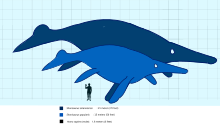Shonisaurus
| Shonisaurus | ||||||||||||
|---|---|---|---|---|---|---|---|---|---|---|---|---|

Shonisaurus popularis |
||||||||||||
| Temporal occurrence | ||||||||||||
| Upper Triassic ( Norium ) | ||||||||||||
| 228 to 208.5 million years | ||||||||||||
| Locations | ||||||||||||
|
||||||||||||
| Systematics | ||||||||||||
|
||||||||||||
| Scientific name | ||||||||||||
| Shonisaurus | ||||||||||||
| Camp , 1976 | ||||||||||||
Shonisaurus is a genus of ichthyosaurs from the Norium (middle Upper Triassic ) of North America. With lengths of 15 to 21 meters, the genus was one of the largest ichthyosaurs.
Discovery story
The first fossils were found in 1928 by Siemon Muller in the US state of Nevada . Under the direction of Charles Camp and Samuel Paul Welles of the University of California, Berkeley , excavations began in 1954. By 1957 and in further excavations in 1963 and 1965, the closely spaced remains of 35 to 40 individuals were recovered, but none of them was completely preserved. In 1976 the type species Shonisaurus popularis was described. The site is now protected as Berlin-Ichthyosaur State Park . Shonisaurus is the state fossil of Nevada.
In 1991 archaeologist Keary Walde discovered the fossil remains of a giant animal while hiking through the forests of British Columbia on the banks of the Sikanni Chief River and reported the discovery to the Royal Tyrrell Museum . The local curator for marine reptiles Elizabeth Nicholls recognized in the fossil a gigantic ichthyosaur that was 23 meters long, 50% longer than Shonisaurus popularis . The fossil was described as Shonisaurus sikanniensis . It is the largest marine reptile described to date. A previously undescribed pliosaur , whose fossil remains were known as the monsters of Aramberri , probably reached a similar size .
features
Shonisaurus had a massive body with a large rib cage . S. sikanniensis was built somewhat more slender than S. popularis . The skull of S. popularis was 2.75 meters long, that of S. sikanniensis reached a length of three meters. The caudal spine was bent down and carried an asymmetrical shark-like fin, with the larger lobe, however, the lower. The muzzle was long and only had teeth in the front, adult animals may not have any teeth at all. Fore and hind fins were the same length, those of Shonisaurus popularis reached a length of 1.5 meters.
literature
- Richard Ellis : Sea Dragons. Predators of the Prehistoric Oceans. University Press of Kansas, Lawrence KS 2003, ISBN 0-7006-1269-6 , p. 89.
Individual evidence
- ↑ a b Ellis, pp. 90-92
- ^ Ellis, 89
- ↑ Palæos, The Norian Age Shonisaurus ( Memento of the original from April 14, 2009 in the Internet Archive ) Info: The archive link was inserted automatically and has not yet been checked. Please check the original and archive link according to the instructions and then remove this notice.
- ^ Ellis, 182
Web links
- Oceans of Kansas Paleontology, Mike Everhart's website Shonisaurus popularis (Eng.)
- Royal Tyrrell Museum - Triassic Giant (Shonisaurus sikanniensis )
